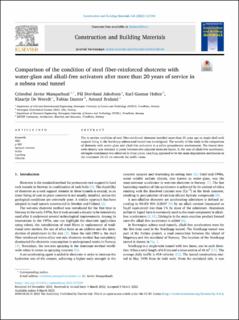| dc.contributor.author | Manquehual, Cristobal Javier | |
| dc.contributor.author | Jakobsen, Pål Drevland | |
| dc.contributor.author | Holter, Karl Gunnar | |
| dc.contributor.author | De Weerdt, Klaartje | |
| dc.contributor.author | Danner, Tobias Alexander | |
| dc.contributor.author | Bruland, Amund | |
| dc.date.accessioned | 2023-01-06T14:21:06Z | |
| dc.date.available | 2023-01-06T14:21:06Z | |
| dc.date.issued | 2022-04-18 | |
| dc.identifier.uri | https://hdl.handle.net/11250/3041648 | |
| dc.description.abstract | The in-service condition of steel fiber-reinforced shotcrete installed more than 20 years ago as single-shell rock support lining in the Nordkapp subsea road tunnel was investigated. The novelty of this study is the comparison of shotcrete with water–glass and alkali-free activators in a saline groundwater environment. The lowest shotcrete density was obtained at joints between two adjacent shotcrete layers. In the case of alkali-free accelerator, ettringite enrichment was observed in these joints. Leaching appeared to be the main degradation mechanism in the outermost 10–15 cm towards the traffic room. | en_US |
| dc.language.iso | eng | en_US |
| dc.title | Comparison of the condition of steel fiber-reinforced shotcrete with water-glass and alkali-free activators after more than 20 years of service in a subsea road tunnel | en_US |
| dc.type | Journal article | en_US |
| dc.source.volume | 328 | en_US |
| dc.source.journal | Construction and Building Materials | en_US |
| dc.source.articlenumber | 127090 | en_US |
